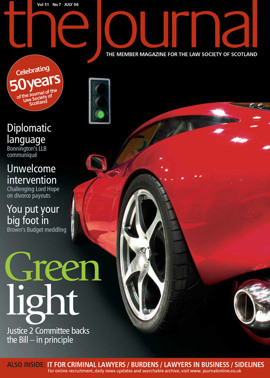Book reviews

Mental Health (Care and Treatment) (Scotland) Act 2003
Ronald A Franks and David Cobb
PUBLISHER: W GREEN
ISBN: 0 414 01578 9
PRICE: £49.50
For more than four decades our mental health law was governed by the Mental Health (Scotland) Act 1960, as repeatedly amended. The 1984 Act consolidated the 1960 Act, taking in the extensive amendments of 1983. Piecemeal amendment continued. However, since 1960 there have been fundamental changes in the ways in which, and places in which, mental disorders are treated; the nature and structure of services; the roles of various professions and of aspects such as patient advocacy and user groups; recognition of families and carers; international trends including those relating to human rights; and above all in much greater recognition of the central position which users of mental health services ought themselves to have.
In 1995 the then Health Minister said of the Mental Health Acts: “There is no clear evidence at present, I believe, to conclude that they fail to meet present day needs or that there is as yet any emerging consensus about how the position might be changed”. That led directly to the “Consensus for Change?” conference organised by the Law Society of Scotland and others in December 1995, the published papers of which made out a persuasive case for fundamental review. A thorough, careful and thoughtful review was carried out by the Millan Committee. The ensuing legislation, though broadly based on its recommendations, was disappointing in two respects. Some of Millan’s proposals were watered down, and the draftsmanship was poor.
The latter point is important. Such legislation is frequently referred to by professionals other than lawyers, and by other interested parties. The “jigsaw puzzle” style of draftsmanship adopted is unhelpful. Anyone seeking to read the Act is confronted at the very beginning with: “Subsections (2) to (4) below apply whenever a person who does not fall within subsection (7) below is discharging a function by virtue of this Act”, followed by: “In discharging the function the person shall, subject to subsection (9) below, have regard to the matters mentioned in subsection (3) below insofar as they are relevant to the function being discharged.” Such an approach poses a major challenge to an annotator aware that his work will be referred to by specialist lawyers, non-specialist lawyers and others who are not lawyers.
The authors have risen admirably to that challenge. These are not the annotations which originally appeared in Current Law Statutes. Rather, they come as close as annotation format permits to providing a major and authoritative text. Thus, where appropriate the authors abandon the traditional format of annotation subsection by subsection, in favour of a coherent text. The reader confronted with the opening provisions quoted above will find in the general note to section 1 a bullet point list of the general principles enacted from the Millan Report, and directions to where each of the relevant provisions is to be found. A similar approach is adopted, for example, to the criteria for an emergency detention certificate in the note to section 36. A less helpful departure from conventional annotation format is the lack of the customary introductory overview of the Act’s content and layout, though this can reasonably be obtained from the list of parts and sections at the beginning of the print of the Act itself.
The authors go beyond the immediate task of annotation. There is much helpful background material, thoughtful analysis and practical comment, evidently based on substantial relevant experience. English and human rights authority is referred to where it assists. Differences with the 1984 Act are highlighted. The authors do not hesitate to question the provisions where warranted. For example, the policy basis (contrary to Millan) on which risk of self-harm is excluded from the criteria for admission to the State Hospital is “curious”; it is “disappointing” that special provision for mothers and babies applies only where the mother is being treated for post-natal depression (though the authors point out that in practice mother and baby units may accommodate mothers with other forms of mental disorder); and in relation to the duties of local authorities to provide care and support services under section 25 it is “unhelpful” that the Act does not specify how, when, on what basis or for how long this should take place.
The only errors noted seem to result from lack of careful proof-reading. For example, the reference on introductory page viii should be to the “Criminal”, not “General”, Procedure (Scotland) Act 1995; and in the note to section 43 the last reference to an “EDC” (emergency detention certificate) should be to a “CTO” (compulsory treatment order).
Notwithstanding such minor points, this book is a “must” for anyone seeking to understand the Act, requiring to refer to its provisions, or seeking guidance in understanding and following them. For years to come it will be seen not only pristine on bookshelves, but well thumbed on desks and on agents’ tables in our courts.
Adrian D Ward
Divorce in the Sheriff Court
S A Bennett
PUBLISHER: S A BENNETT
ISBN: 0 953 41526 0
PRICE: £50
Another year, another edition of Siggi Bennett’s book on divorce in the sheriff court to review…
This is the seventh edition (2005) of this particular book, which has seen a number of publishers. It is now self-published.
Among other changes to the latest edition is the fact that it is now in soft cover format. It has also expanded considerably from 275 pages in the last edition to 367 pages in the current edition.
Where this book really scores is in the handy collection of various source materials. I did wonder though whether the book would be even better if it included the family action sheriff court rules, as many of the rules would be directly relevant to the contents of the book. The additional material could surely have been included without the book becoming too unwieldy. That is however just a minor criticism.
The material collected is impressive nonetheless. It is particularly helpful in relation to the new and rather complicated rules on jurisdiction. You get the Divorce etc (Pensions) (Scotland) Regulations and helpfully you also get what appears to be a reasonably full list of all reported cases involving judicial consideration of the section 9 principles. The book also includes a handy list of all reported cases relating to judicial consideration of section 11 of the Children (Scotland) Act 1995.
It does need to be pointed out however that the discursive material in the book amounts to a fraction of this overall content – about 100 pages as against over 200 pages of materials. It also has to be borne in mind that much of the discursive material really amounts to repetition of the relevant statutory provisions and rules. For this reviewer at least, that is not a major consideration because clearly this book does not intend to be a competitor to Clive’s Husband and Wife. I have previously wondered though what niche the book was intended to occupy, since presumably it is intended to be more than just a basic guide.
Ultimately these books do different things and in this reviewer’s opinion at least, Bennett’s book does exactly what it says on the tin. It is extremely useful as a first point of reference and also for the more complicated aspects of divorce law and procedure. For example, it is a book I always turn to when I need to remember what the position is in relation to the use of an accommodation address. Many lawyers seem blissfully unaware that its use has to be justified in the pleadings.
Where the book arguably fails is in relation to some of the styles provided in the appendix. It has to be pointed out that some of these have been the subject of some robust judicial criticism, as this reviewer can attest from personal experience. For example, one will look in vain for the essential (and barely adequate at that) averment that the parties are designed in the instance. The style craves for section 11 orders in relation to children also omit any references to the 1995 Act.
I think therefore it might be advisable to use the styles with caution. However with that minor quibble, I’d still happily recommend this book and in fact have bought many of the previous editions myself.
Alistair Gordon
In this issue
- Challenging times
- A block on service
- Revving up for debate
- LLB confidential
- Clean break under attack
- The hokey-cokey Chancellor
- Switching channels
- The Chancellor gets it REIT
- Executries sponsored feature
- The EU and the criminal
- Case for the defence
- To act or not to act... that is the question!
- A summary matter
- Ireland 4, Italy 0
- The route ahead
- Scottish Solicitors Discipline Tribunal
- Website reviews
- Book reviews
- Is that burden dead yet?






